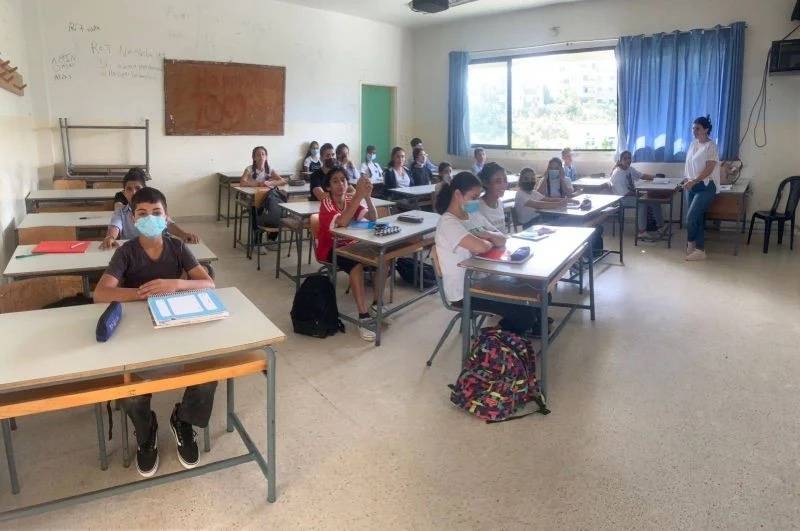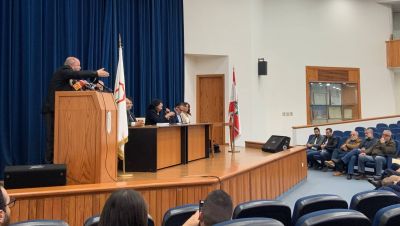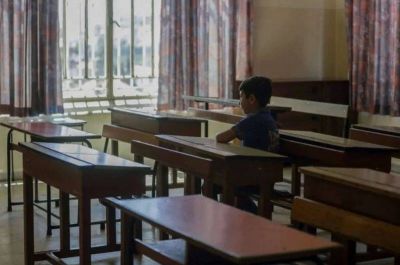
Students at a middle school in Abra, South Lebanon, on Oct. 3, 2022. (Credit: Muntasser Abdallah/L'Orient Today)
Earlier this month, the Education Ministry issued dollar payments to teachers for the first time.
The ministry made this payment via money transfer company OMT as one of its promised concessions to break the teachers’ open strike.
Teachers have been striking on and off for months to protest their deteriorating living conditions.
To incentivize them to return to school, the Education Ministry promised teachers a bonus of up to $100 per month, depending on the number of days they appeared in school during the last three months of 2022.
A ministry statement also said it will offer up to $125 per month if teachers attend school in the four remaining months of the school year (i.e., March to June 2023).
On Feb. 15, the government authorized a treasury advance of LL1.05 trillion to the Education Ministry “to support teachers, contractors and workers in schools, high schools, official technical institutes and the Lebanese University.”
According to a source in the Education Ministry, the treasury advance was meant to finance these incentives. L’Orient Today contacted a Finance Ministry spokesperson, who confirmed this information.
The incentive payments were also funded by the World Bank, the United Nations Children’s Fund (UNICEF), the UK’s Foreign Commonwealth and Development Office, and the EU, according to the Education Ministry’s statement and a UNICEF statement.
The head of UNICEF in Lebanon, Edouard Beigbeder, told L’Orient Today that it was the Education Ministry’s idea to transfer the funds through OMT.
Asked about the choice to operate via OMT instead of via the central bank, Beigbeder highlighted the importance of teachers obtaining the “real” value of the money given by donor countries, and referenced the potential risks involved in transacting through the central bank’s Sayrafa platform.
“You can’t allow from the day you start through the payment process a diminishing of an important amount between what was given from taxpayers in different countries to what will go to the teachers. We need whatever we give to the teachers to be the same, in the real sense of the money, value,” he explained.
Ghassan Doulani, an elementary school teacher, told L’Orient Today that a similar incentive system was implemented last year under which teachers were given up to $90 dollars for each month they attended school. But at that time, the money was transferred through Lebanon’s commercial banks, which in turn paid the teachers in lira at the Sayrafa rate. Because the Sayrafa rate is usually lower than the parallel market rate, teachers in reality received less than $90.
By choosing to operate via OMT, the Education Ministry also avoids the issue of banking sector strikes, which occurred on and off for several months, making it difficult for depositors to access their incentive payments.
A process with some hiccups
Teachers went on strike in January to protest deteriorating living conditions.
Their core salaries, though tripled by the 2022 budget, are still paid in lira. This means their salaries have drastically lost value in line with the lira’s depreciation against the dollar over the last three years.
Before the onset of the economic crisis in 2019, the Lebanese lira maintained a stable official peg of LL1,507.5 to the US dollar. As the crisis deepened, a parallel market for the currency emerged, on which the lira moved ever further away from this peg. On Tuesday, the lira was trading at LL107,000 to the dollar on this market. Given this depreciation, the average LL7 million monthly salary of a school principal is now worth approximately $65.
Teachers interviewed by L’Orient Today said that on March 10 they received a text message from OMT informing them that they could withdraw their October 2022 incentive payment from the money transfer company. They received a second text message on March 20 informing them that they could receive their payments for November and December 2022 via OMT.
However, Bassel Yassine, a technical school teacher in Beirut, told L’Orient Today that most technical school teachers did not receive the March 10 text about their payments. Other teachers contacted by L’Orient Today said the same.
Speaking to L’Orient Today, a spokesperson for the Education Ministry said some teachers had not received the text due to technical problems, such as incorrect names or phone numbers in its database.
The spokesperson also told L’Orient Today that the ministry could not provide the exact percentage of teachers who have already received their payments.
Teachers’ requests
The incentive payments promised by the government are not the only demand made by the teachers as part of their open-ended strike.
Teachers are also requesting an adjustment of their salaries and for their salaries to be paid in dollars, though the teachers themselves have not yet agreed upon an exchange rate for the conversion of their salaries from lira to dollars.
As talks continue between teachers and the Education Ministry, a large number of teachers have chosen not to abide by their syndicate's decision to cease the open-ended strike.
On March 19, a survey conducted by the syndicate showed that only 870 out of 3,810 technical institution teachers supported the idea of the resumption of classes, prompting their syndicate to resume the strike the next day, Yassine told L’Orient Today.
Khodor Najdi, a high school teacher at the public school of Kfar Shima in the Baabda area of Mount Lebanon, told L’Orient Today that he observed that high school teachers were less likely to end the strike and resume their classes than elementary and technical school teachers. He said he believes that this is because the percentage of contract teachers — who must attend classes in order to qualify for payment — in elementary and technical schools is higher than in high schools. Non-contract teachers — i.e., those with permanent positions — get paid whether they attend classes or not.
Doulani agreed. He said contract teachers “have to swallow a knife,” meaning they cannot afford to remain on strike even if they wish to do so.
Doulani also said he is the only teacher in his school who decided not to abide by the syndicate's decision and stay on strike.
“It’s a policy of separation — to divide the teachers so that they can control our demands, because our concerns are different,” Doulani said.
Additional reporting by Richard Salame


